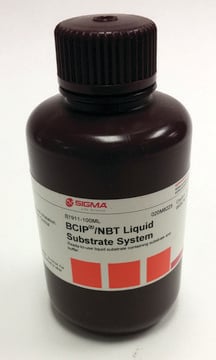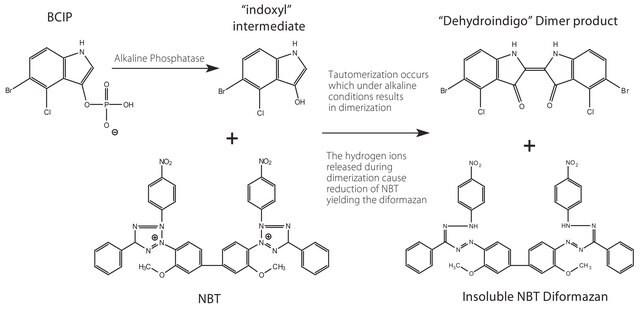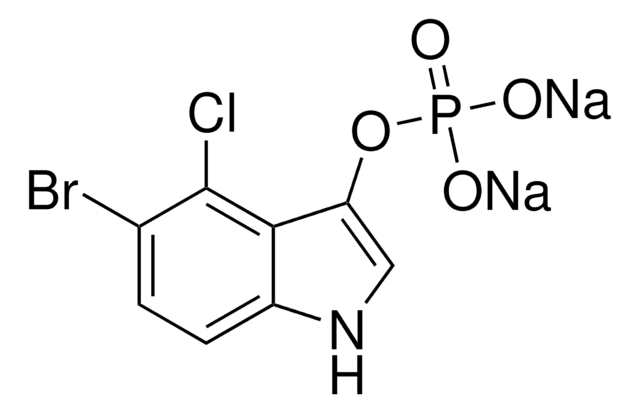11383213001
Roche
NBT
4-Nitro blue tetrazolium chloride, solution
Sinônimo(s):
Nitroblue tetrazolium chloride
About This Item
Produtos recomendados
Nível de qualidade
Ensaio
>95%
forma
solution
peso molecular
Mr 817.7
embalagem
pkg of 3 mL (300 mg)
fabricante/nome comercial
Roche
técnica(s)
Northern blotting: suitable
Southern blotting: suitable
hybridization: suitable
temperatura de armazenamento
−20°C
Descrição geral
Aplicação
- Immunohistocytochemistry
- Western blot
- Southern blot
- Northern blot
- Colony and plaque hybridization
- In situ hybridization
forma física
Note: The color does not impair the quality or the function of the reagent. In some cases a precipitate may occur which is easily brought into solution by briefly warming the substrate at 37 °C.
Nota de preparo
- Always prepare this solution fresh shortly before use!For all applications except DIG System: Add 50 μl NBT solution and 37,5 μl BCIP to 10 ml 0.1 M Tris-HCl, pH 9.5 (20 °C), 0.1 M NaCl, 0.05 M MgCl2.
- For DIG System applications: Add 50 μl NBT solution and 37,5 μl BCIP to 10 ml 0.1 M Tris-HCl, pH 9.5 (20 °C), 0.1 M NaCl
- Note: Do not include MgCl2 in the DIG detection buffer as this might lead to spotty background on the membrane after the detection procedure. Alkaline Phosphatase does not require Mg2+.
Outras notas
Palavra indicadora
Danger
Frases de perigo
Declarações de precaução
Classificações de perigo
Acute Tox. 4 Inhalation - Eye Irrit. 2 - Repr. 1B
Código de classe de armazenamento
6.1C - Combustible acute toxic Cat.3 / toxic compounds or compounds which causing chronic effects
Classe de risco de água (WGK)
WGK 2
Ponto de fulgor (°F)
167.0 °F
Ponto de fulgor (°C)
75 °C
Certificados de análise (COA)
Busque Certificados de análise (COA) digitando o Número do Lote do produto. Os números de lote e remessa podem ser encontrados no rótulo de um produto após a palavra “Lot” ou “Batch”.
Já possui este produto?
Encontre a documentação dos produtos que você adquiriu recentemente na biblioteca de documentos.
Os clientes também visualizaram
Conteúdo relacionado
There are several counterstains possible in combination with BM Purple (or NBT/BCIP in general), including FastGreen FCF and Nuclear Fast Red.
Nossa equipe de cientistas tem experiência em todas as áreas de pesquisa, incluindo Life Sciences, ciência de materiais, síntese química, cromatografia, química analítica e muitas outras.
Entre em contato com a assistência técnica









